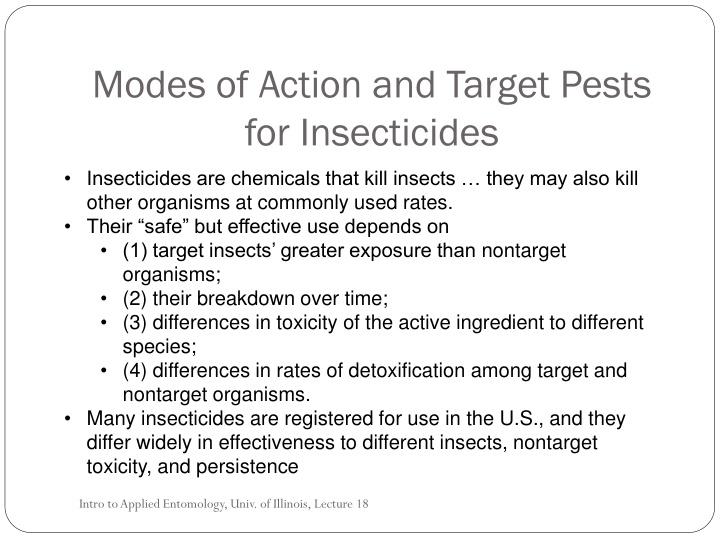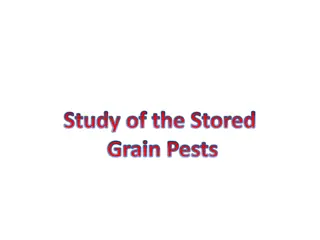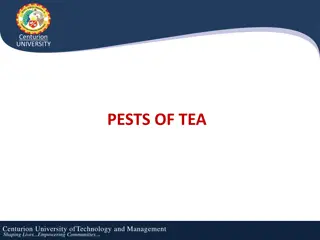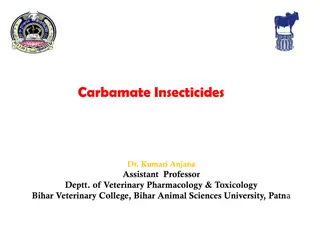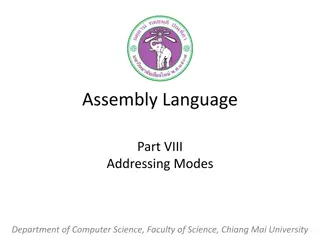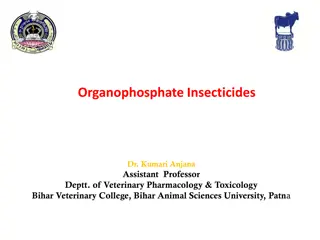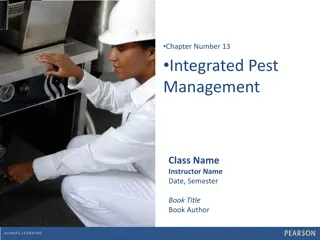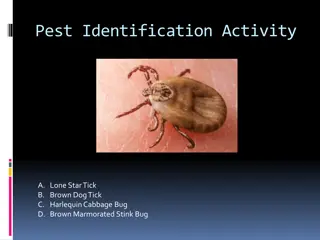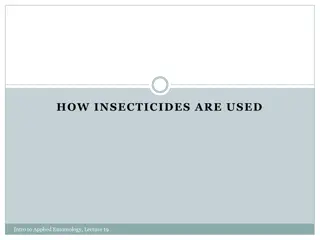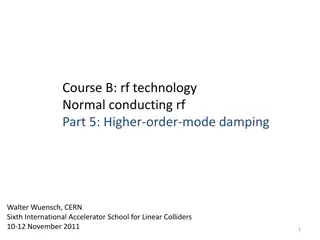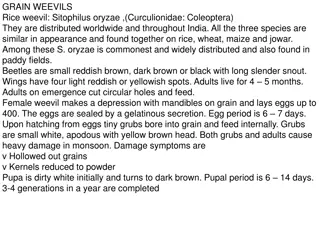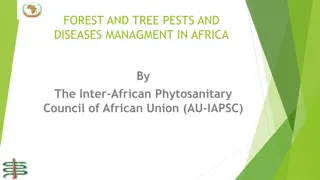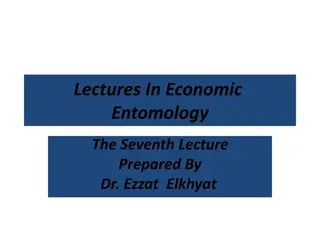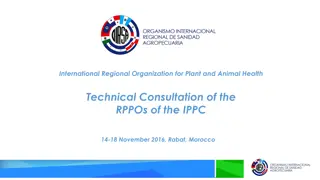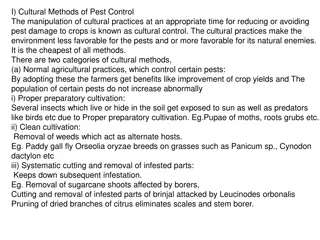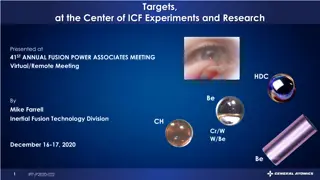Overview of Insecticides: Modes of Action, Target Pests, and Types
Insecticides are chemicals used to kill insects, but their effectiveness and safety depend on various factors like target specificity, breakdown over time, and toxicity differences. Different classes of insecticides such as Organochlorines, Organophosphates, Carbamates, Pyrethroids, and Neonicotinoids have unique modes of action, target pests, and environmental impacts. Understanding these factors is crucial for effective pest management practices.
Download Presentation

Please find below an Image/Link to download the presentation.
The content on the website is provided AS IS for your information and personal use only. It may not be sold, licensed, or shared on other websites without obtaining consent from the author.If you encounter any issues during the download, it is possible that the publisher has removed the file from their server.
You are allowed to download the files provided on this website for personal or commercial use, subject to the condition that they are used lawfully. All files are the property of their respective owners.
The content on the website is provided AS IS for your information and personal use only. It may not be sold, licensed, or shared on other websites without obtaining consent from the author.
E N D
Presentation Transcript
Modes of Action and Target Pests for Insecticides Insecticides are chemicals that kill insects they may also kill other organisms at commonly used rates. Their safe but effective use depends on (1) target insects greater exposure than nontarget organisms; (2) their breakdown over time; (3) differences in toxicity of the active ingredient to different species; (4) differences in rates of detoxification among target and nontarget organisms. Many insecticides are registered for use in the U.S., and they differ widely in effectiveness to different insects, nontarget toxicity, and persistence Intro to Applied Entomology, Univ. of Illinois, Lecture 18
Overview Insecticides by chemical structure and modes of action Why structures and modes of action matter What s effective against what? Alternative insecticides Available references Intro to Applied Entomology, Univ. of Illinois, Lecture 18
Insecticides Organochlorines endosulfan (Thiodan, Endosulfan, Thionex) (Group 2A) Organophosphates (Group 1B) clorethoxyfos (Fortress) chlorpyrifos (Lorsban, Dursban, many more) diazinon (Diazinon) dimethoate (Cygon, Dimate, Dimethoate) malathion methyl parathion (Penncap-M) terbufos (Counter) Carbamates (Group 1A) acephate (Orthene) carbaryl (Sevin) carbofuran (Furadan) methomyl (Lannate) thiodicarb (Larvin) Organochlorines were the first synthetic organic insecticides. Many were very persistent in the environmnent. Organophosphates and carbamates were developed in the 1950s through 1980s they are less persistent, but several were more acutely toxic to mammals, posing greater risks to applicators. Intro to Applied Entomology, Univ. of Illinois, Lecture 18
Pyrethroids came to market primarily in the 1980s and 1990s. Their mode of action is similar to that of DDT, but they are much less persistent and effective at greatly lower doses. Insecticides Pyrethroids (Group 3) bifenthrin (Capture, Brigade, Bifenthrin, Bifenture, Discipline, Fanfare, Sniper, Tundra, more) cyfluthrin (Baythroid, Renounce, Tombstone, more) cypermethrin (Ammo) esfenvalerate (Asana, Adjourn) fenpropathrin (Danitol) lambda-cyhalothrin (Warrior, Silencer, more) (related, gamma cyhalothrin = Pro-axis) permethrin (Ambush, Pounce, Arctic, Permethrin, Perm-UP, and more) tefluthrin (Force) zeta-cypermethrin (Mustang Max) Intro to Applied Entomology, Univ. of Illinois, Lecture 18
Neonics were first marketed in the late 1980s, and many new products came to market during the last 20 years. Insecticides Neonicotinoids (Group 4A) acetamiprid (Assail) clothianidin (Poncho) imidacloprid (Admire, Provado, Couraze, Imida, Macho, Malice, Montana, Nuprid, Torrent, Widow, more) dinotefuran (Venom) thiamethoxam (Actara, Platinum, Cruiser) Intro to Applied Entomology, Univ. of Illinois, Lecture 18
Insecticides Many other chemical structures have been identified as insecticidal and satisfactorily low in nontarget toxicity, persistence, etc. Spinosyns (Group 5) spinosad (Tracer, Entrust) spinetoram (Radiant) Diacyl hydrazines (Group 18) methoxyfenozide (Intrepid) tebufenozide (Confirm) azadirachtin (neem) Phenylpyrazoles (Group 2) fipronil (Regent) Intro to Applied Entomology, Univ. of Illinois, Lecture 18
Additional groups Avermectins and similar compounds (Group 6) abamectin (Agri-Mek, Abba, Epi-Mek, Zoro) emamectin benzoate (Proclaim) Juvenile hormone analogs (Group 7) pyriproxyfen (Esteem) Benzoylureas (Group 15) Diflubenzuron (Dimilin) Novaluron (Rimon) Indoxacarb (Group 22) Indoxacarb (Avaunt) Tetronic acid derivatives (Group 23) Spirotetramat (Movento) Anthranilic diamides (Group 28) chlorantraniliprole (Altacor, Coragen) flubendiamide (Belt/Synapse) Intro to Applied Entomology, Univ. of Illinois, Lecture 18
Other types of chemical structures are used as miticides a pesticide that is widely effective against a range of insects usually is NOT effective against mites. Miticides Organochlorines dicofol (Kelthane, Dicofol) (Group un) Avermectins (Group 6) abamectin (Agri-Mek, Abba, Epi-Mek, Zoro) Tetronic acid derivatives (Group 23) spiromesifen (Oberon) Neuronal inhibitors bifenazate (Acramite) (Group 25) Intro to Applied Entomology, Univ. of Illinois, Lecture 18
Structural groupings An Introduction to Insecticides, by George Ware, at http://ipmworld.umn.edu/chapters/ware.htm Insecticides: Chemistries and Characteristics, by Jeffrey Bloomquist, at http://ipmworld.umn.edu/chapters/bloomq.htm Intro to Applied Entomology, Univ. of Illinois, Lecture 18
Insecticide Modes of Action IRAC Mode of Action Classification Insecticide Resistance Action Committee 28+ modes of action and insecticide groups http://www.irac-online.org/documents/moa-classification/?ext=pdf http://pested.okstate.edu/pdf/insecticide%20moa.pdf http://www.irac-online.org/content/uploads/IRAC-general-MoA-Poster-v2- 2_Mar2012.pdf Intro to Applied Entomology, Univ. of Illinois, Lecture 18
Insecticide Modes of Action Group 1: Acetylcholinesterase inhibitors 1A: carbamates: Sevin, Furadan, Orthene, Lannate, Vydate 1B: organophosphates: Counter, Fortress, Lorsban, Diazinon, Dimethoate, Malathion, Penncap-M Group 2: GABA-gated chloride channel antagonists 2A: Endosulfan (an organochlorine); 2B: Regent Group 3: Sodium channel modulators (DDT, methoxychlor) all pyrethroids, and natural pyrethrins Group 4: Nicotinic acetylcholine receptor promoters and antagonists 4A: neonicotinoids: Assail, Admire/Provado, Actara/Platinum, Venom Intro to Applied Entomology, Univ. of Illinois, Lecture 18
Insecticide Modes of Action Group 5: Nicotinic acetylcholine receptor promoters (different from Group 4) spinosad (SpinTor, Entrust) spinetoram (Delegate, Radiant) Group 6: Chloride channel activators abamectin (Agri-Mek) emamectin benzoate (Proclaim) Group 7: Juvenile hormone mimics pyriproxyfen (Esteem); others include hydroprene, kinoprene, methoprene, and fenoxycarb) Intro to Applied Entomology, Univ. of Illinois, Lecture 18
Insecticide Modes of Action Group 11: Microbial disruptors of insect midgut membranes: Bacillus thuringiensis (with multiple subspecies) (and multiple trade names) Group 15: Chitin inhibitors Diflubenzuron (Dimilin) novaluron (Rimon) Group 18: Ecdysone (molting hormone) promoters / mimics & molting disruptors tebufenozide (Confirm), methoxyfenozide (Intrepid) Intro to Applied Entomology, Univ. of Illinois, Lecture 18
Insecticide Modes of Action Group 21: Mitochondrial electron transport inhibitors rotenone Group 22: Voltage-dependent sodium channel blockers indoxacarb (Avaunt) Group 23: Lipid synthesis inhibitors spiromesifen (Oberon) Spirotetramat (Movento) Group 28: Ryanodine receptor modulators chlorantraniliprole (Altacor, Coragen) flubendiamide (Belt/Synapse) Group un: Unknown mode of action dicofol (Kelthane), azadirachtin (neem) Intro to Applied Entomology, Univ. of Illinois, Lecture 18
So why are chemical structures and modes of action important? Insecticides work if (1) they remain intact within an insect to reach a target site and (2) the target site is susceptible to their attachment and interference. Differences among species in natural susceptibility to an insecticide and evolution of resistance in populations of a given species result primarily from (1) increased metabolism or breakdown of insecticide molecules related to their structure and from (2) receptor sites that are not susceptible to insecticide attachment and interference. Repeated use of insecticides within the same structural family or mode of action group result in more rapid development of resistance Rotating among structural families and modes of action assuming there are alternatives that are effective is recommended to maximize long-term effectiveness of insecticides and miticides. Intro to Applied Entomology, Univ. of Illinois, Lecture 18
So what is the range of target pests for the different groups / modes of action? Group 1A, carbamates, acetylcholinesterase inhibitors Furadan: few remaining labeled uses. Orthene: effective against aphids and certain Leps. Sevin: effective against many beetles; not great against most Leps; kills natural enemies of aphids and mites and triggers their outbreaks in susceptible crops. Larvin and Lannate some Lep activity (generally not as effective as pyrethroids), some aphid activity. Lannate s residual activity is very short. Of these, only Sevin (carbaryl) is used widely. Intro to Applied Entomology, Univ. of Illinois, Lecture 18
Group 1B, organophosphates, acetylcholinesterase inhibitors Counter and Fortress: soil-applied for corn rootworm control Lorsban: Soil and seed treatment uses against root and seed maggots, corn rootworm larvae, wireworms, and white grubs; foliar uses against miscellaneous, Leps, beetles, aphids Diazinon: Seed treatment uses against seed maggots, wireworms, white grubs Dimethoate: Moderately effective against aphids and leafhoppers, some miticidal action. Malathion: Most often used against aphids Penncap-M: Miscellaneous uses against Leps, aphids, and beetles. Intro to Applied Entomology, Univ. of Illinois, Lecture 18
Group 3, pyrethroids and natural pyrethrins, sodium channel modulators Pyrethroid products include Permethrin, Asana, Capture/Brigade, Baythroid/Renounce, Danitol, Force, Warrior/Proaxis, Mustang Max. Natural pyrethrins include Pyganic, Pyrenone, etc. In general, all pyrethroids are good against a range Leps and beetles, as well as grasshoppers, stink bugs, plant bugs, and some thrips. Most compounds in this group are ineffective against most aphids and mites and trigger more severe infestations of these pests by killing their natural enemies. Force is labeled for soil use against corn rootworm larvae. Natural pyrethrins are effective against several beetles but break down very rapidly. Using synergists (not OMRI-approved) and spraying at night increases effectiveness. Intro to Applied Entomology, Univ. of Illinois, Lecture 18
Group 4A, neonicotinoids, nicotinic acetylcholine receptor promoters and antagonists Products that are active primarily against aphids, leafhoppers, etc. (plus systemically against corn flea beetle) include Gaucho, Cruiser, and Poncho, Admire, Provado, Venom, etc. Group 5, spinosyns, nicotinic acetylcholine receptor promoters that differ from group 4A Tracer/SpinTor, Entrust, Delegate and Radiant effective primarily against Lep larvae Intro to Applied Entomology, Univ. of Illinois, Lecture 18
Effective primarily against Lepidopteran larvae Group 6: Chloride channel activators emamectin benzoate (Proclaim) Group 11: Microbial disruptors of insect midgut membranes: Bacillus thuringiensis (with multiple subspecies) (and multiple trade names) Group 15: Chitin inhibitors Novaluron (Rimon) (also effective against Colorado potato beetle) Group 18: Ecdysone (molting hormone) promoters / mimics & molting disruptors 18A: tebufenozide (Confirm), methoxyfenozide (Intrepid) Group 22: Voltage-dependent sodium channel blockers indoxacarb (Avaunt) Group 28: Ryanodine receptor modulators chlorantraniliprole (Altacor/Coragen) flubendiamide (Belt/Synapse) Intro to Applied Entomology, Univ. of Illinois, Lecture 18
Specific miticides Group 6: Chloride channel activators abamectin (Agri-Mek) Group 23: Lipid synthesis inhibitors spiromesifen (Oberon) (also effective against whiteflies) Group 25: Neuronal inhibitors (unknown mode of action) bifenazate (Acramite) Group un: Unknown mode of action dicofol (Kelthane) Pyrethroids that have some miticidal action include Capture and Danitol, but these are not usually the best choices for mite control. Intro to Applied Entomology, Univ. of Illinois, Lecture 18
Resistance Management Simple rules: Do not use insecticides in the same MOA group repeatedly in the same crop/field/season Rotate among MOAs at least across generations Where an insect pest is not controlled by application(s) of an insecticide in a given MOA group, do NOT switch to another insecticide within the same MOA group If the target pest migrates into the region from an area with known resistance to a particular MOA, do not rely on an insecticide from that MOA group for control at your site Intro to Applied Entomology, Univ. of Illinois, Lecture 18
Alternative insecticides Benefits: Less persistent in the environment Less toxic to nontarget organisms More specific modes of action Examples include Botanical insecticides Synergists may be beneficial Soaps and oils Microbial insecticides Growth regulators Pheromones Intro to Applied Entomology, Univ. of Illinois, Lecture 18
Botanicals Prepared from plants Crude dusts or powders (pyrethrum) Extracts or resins (pyrethrins, neem seed oils) Isolated, refined components (d-limonene, linalool) Always -- minimal alteration of naturally occurring compounds Strengths and weaknesses Rapid action Rapid degradation Low toxicity to mammals (in general, not always) Minimal technology required for preparation Intro to Applied Entomology, Univ. of Illinois, Lecture 18
Older botanicals and their origins Nicotine Nicotiana spp. Pyrethrins Chrysanthemum cinerariaefolium Rotenone Derris, Lonchocarpus and other legumes Sabadilla Schoenocaulon officinale (a tropical lily) Similar veratrine alkaloids in white hellebore, Veratrum album Ryania Ryania speciosa Others Soaps, horticultural oils, essential oils, diatomaceous earth Intro to Applied Entomology, Univ. of Illinois, Lecture 18
Modes of action, toxicity, and uses of old organic insecticides derived from plants Acetylcholine mimic Toxicity: Mod-High (dermal and oral) Greenhouse / Homoptera Nicotine Na+ / K- ion trans in axons Toxicity: Low Animals, humans, organic crops Beetles in organic crops Pyrethrins Electron transfer in cellular respiration Nerve membrane function Toxicity: Moderate (implicated in Parkinson s disease) Toxicity: Low (but mucous membrane irritant) Toxicity: Low Rotenone Squash bug Sabadilla Calcium channel disruptors (axonic) Beetles, caterpillars in organic crops Ryania Intro to Applied Entomology, Univ. of Illinois, Lecture 18
Regulatory and marketing status in the United States Only pyrethrins are widely available with labels covering a range of crop, animal, indoor, and human uses Intro to Applied Entomology, Univ. of Illinois, Lecture 18
More recent botanicals (and similar ingredients) and their origins Linalool and d-limonene citrus oil derivatives Neem Azadirachta spp. and Melia spp. Garlic oils Hot pepper oils Microbials Toxins from Bacillus thuringiensis and other soil micro-organisms (avermectins, spinosyns) Azadirachta windbreak. (E. Fernandez, http://www.css.cornell.edu/ ecf3/Web/new/AF/arid.html) Intro to Applied Entomology, Univ. of Illinois, Lecture 18
Modes of action, toxicity, and uses Nerve cell stimulants Toxicity: Low On pets, indoor plants Citrus derivatives Multiple actions, ecdysone agonist Toxicity: Very Low (medicinal uses) Toxicity: Low Many crop pests Neem ? Many labeled uses, limited positive data on effectiveness Garlic oil ? Toxicity: Low Hot pepper extracts Multiple Toxicity:Low Many for Bt and other products Microbials Intro to Applied Entomology, Univ. of Illinois, Lecture 18
Effectiveness of currently available botanicals Older botanicals Generally well understood based on field trials and small plot trials from 1920s through 1950s More recent products More unsupported label claims Intro to Applied Entomology, Univ. of Illinois, Lecture 18
Insecticidal soaps Salts of fatty acids Kill insects by disrupting membranes (including tracheal linings) Work only against those insects that are wetted by the spray ... no residual action Effective against aphids, whiteflies, mites, and other soft-bodied, not-too-mobile pests Best-known brand names are Safer s and M-Pede Intro to Applied Entomology, Univ. of Illinois, Lecture 18
Oils may be vegetable oils or highly refined petroleum oils Dormant oils for fruit and landscape trees Against overwintering aphid eggs, mite eggs, scales Stylet oils reduce virus transmission, may suppress powdery mildew Summer oils Against mites, aphids, other soft-bodied pests Coverage is essential (upper and lower leaf surfaces); oils kill by suffocating pests that are sprayed directly Intro to Applied Entomology, Univ. of Illinois, Lecture 18
Absorbents & abrasives Clays, diatomaceous earth, silica aerogels disrupt the insect s cuticle and kill by dehydration Kaolin ... Surround Intro to Applied Entomology, Univ. of Illinois, Lecture 18
Elemental and naturally occurring chemicals Sulfur effective miticide (may cause plant injury) Copper Intro to Applied Entomology, Univ. of Illinois, Lecture 18
Microbials Bacteria Viruses Fungi Microsporidia (Protozoans) Nematodes Intro to Applied Entomology, Univ. of Illinois, Lecture 18
Insect growth regulators Because they are enclosed in an exoskeleton, insects must "shed their skins", or molt, to grow larger. The molting process in immatures and the transformation from larva to pupa to adult is regulated by hormones. One is ecdysone (molting hormone) secreted by the prothoracic gland; it stimulates shedding of the cuticle. Another is juvenile hormone (JH). JH is secreted from the corpora allata; it suppresses adult characteristics. As growth during each stage triggers secretion of ecdysone, if juvenile hormone is present, the cuticle is shed and replaced, and the insect reaches its next juvenile stage. As the immature insect grows and eventually discontinues production of juvenile hormone, secretion of ecdysone in the absence of JH triggers pupation and subsequent development of adult form. Synthetic hormones that mimic JH and ecdysone have been developed for use as insecticides that disrupt insect development and cause death. Intro to Applied Entomology, Univ. of Illinois, Lecture 18
Juvenile hormone mimics methoprene hydroprene kinoprene pyriproxyfen Intro to Applied Entomology, Univ. of Illinois, Lecture 18
Chitin inhibitors diflubenzuron (Dimilin) lufenuron (Program) (not widely used) buprofezin hexaflumuron (Sentricon termite control) novaluron (Rimon) novaluron Intro to Applied Entomology, Univ. of Illinois, Lecture 18
Ecdysone agonists (= promoters) tebufenozide (Confirm) methoxyfenozide (Intrepid) halofenozide (Mach 2, against cutworms in turf) Existing compounds target Lepidoptera methoxyfenozide Intro to Applied Entomology, Univ. of Illinois, Lecture 18
Useful References The Bulletin: Pest Management and Crop Development Information for Illinois http://bulletin.ipm.illinois.edu/ Annual Summary of Field Crop Insect Management Trials, Department of Crop Sciences, University of Illinois http://ipm.illinois.edu/ontarget/ 2014 Midwest Vegetable Production Guide http://btny.purdue.edu/Pubs/ID/ID-56/ 2014 Midwest Small Fruit and Grape Spray Guide https://ag.purdue.edu/hla/Hort/Documents/ID-169.pdf 2014 Midwest Tree Fruit Spray Guide https://store.extension.iastate.edu/Product/2014-Midwest-Tree-Fruit- Spray-Guide Intro to Applied Entomology, Univ. of Illinois, Lecture 18
